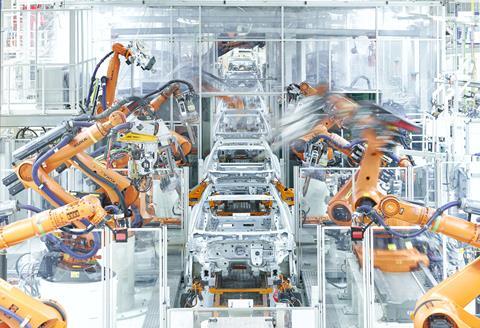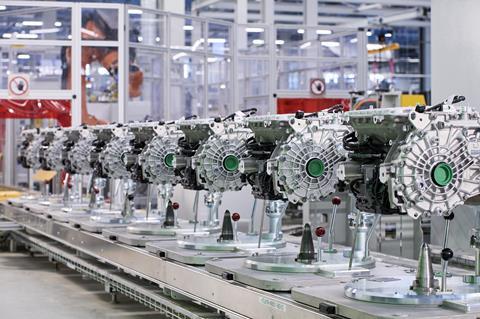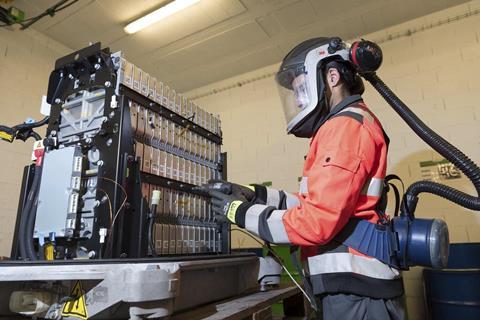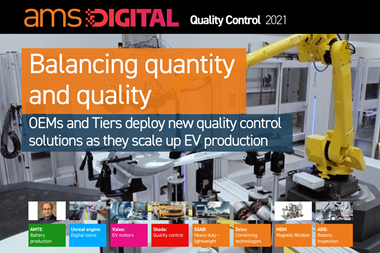The shift to production of electric vehicles and the impact of the Covid 19 has caused considerable disruption to automotive supply chains. AMS spoke to Neil Endley, Global Director for Turnaround Services, to get some insights into the challenges facing OEM and tier suppliers in the automotive sector

Paris-based Trigo Turnaround Services is a specialist in providing manufacturing services and business leadership to numerous tier one, two and three automotive manufacturers. Following his recent appointment to Global Director and chair to its eMobility Strategic Global Development Steering Group Neil Endley discusses ‘parachuting’ teams onto assembly lines to ensure on time delivery is efficiently achieved and maintained and, more importantly, how the traditional vehicle manufacturing meets the new in EV production challenges.

AMS: What key services do you offer that are in demand from the automotive sector at?
Neil Endley (NE): What we do, in its simplest form, is to provide a resolution service to any areas or issues that put a constraint on management and the performance of the manufacturing site. So, anywhere there is a supply chain constraint or negative performance. A typical example might be an OEM that needs to localise greater production in a particular region, and we will provide a full support service, from identifying suppliers that meet the required standards to provide skilled individuals from right across the spectrum to ensure demands and targets are achieved.
On the reactive side, the issue might be a chronic supply chain breakdown. We are often deployed to manage that chronic supply situation, largely where there’s systemic failing in that supply chain. Our teams firstly ensure delivery of product while investigating the root cause(s) behind those issues and then develop a recovery plan of action which, often, includes deploying dedicated teams to support those businesses to ensure the situation is recovered and sustainable delivery is ensured.
One of the key challenges is not just to fix [a particular issue]. You’ve got to have a healthy supply chain in an industry where there’s not much room for error. It’s very easy for manufacturers, be it OEMs or their first tier, second and third tier suppliers, to get to a tipping point and start losing vast sums of money.
AMS: As well as dealing with the inbound supply chain do you deal with anything in terms of the way materials flow through the plant?
NE: Yes. We look at everything from plant layout, movement of material, procurement, procurement scheduling, the conversion process is the plant itself and manufacturing the parts. We’ll work right the way back down to Tier 2, Tier 3, Tier 4. A recent project is a perfect example of this – a Tier 1 client turned to us with a problem and our investigations found that the cause of the issue was at the Tier 4 element of the process which was swiftly and easily rectified. So, our job is really interrogating that supply chain and getting to the systemic failings that’s creating the failure at an OEM level.
AMS: The lack of visibility further down the supply chain is a problem for even the biggest manufacturer. Do you think the transparency of the supply chain has improved in recent years, especially since we’re seeing more data transfer between suppliers and clients?
NE: Yes and no! Certainly, we have greater traceability and thus transparency of data throughout the supply chain however the challenge is what we do with it! Automotive tier suppliers operate in an extremely competitive market with tight margins and very little room for error. They are also exposed to any volatility in supply and demand. An OEM schedule an order for a certain number of parts to be produced to a specific cost, quality and deadline. If any of those targets are missed, the manufacturer can, and often do, lose the business if this performance level continues over a sustained period. If the vehicle doesn’t sell at the predicted volume or the automotive market slows then the order, which the tier supplier has geared its factory to produce, might be adjusted down or even cancelled. So, this challenging business model forces costs down pressures throughout the supply chain. Technology and improved data sharing have increased transparency, especially as there is now far more scrutiny regarding the use of ethical suppliers, but it is still very difficult to manage quality and supply across very long, global supply chains with such cost and performance pressures.
Now the OEMs and tier suppliers are having to deal with the shift to electric vehicle (EVs) and this is seeing new supply chains emerging. And this is bringing new challenges, not least in terms resource and skills shortages.

AMS: Focusing on some of the operational challenges, what are the current demands from your automotive clients, what areas are they specifically looking at improving?
NE: Challenges often centre around control, performance and cost ultimately predictable and stable supply. When setting up production and supply chains to manufacture vehicles there’s a tolerance of error (as with any supply chain) within the business model albeit incredibly small. Problems arise when something goes out of control of those limits for any number of reasons. Looking at current vehicles its clear to say the level of technology has hugely increased in a car however due to the competitive nature of the business the overall cost, over time, has been significantly driven down which low-cost sourcing strategies has played a major part by producing components in relatively low-cost regions. However, when that supply chain fails, you’ve may have several weeks of components that are in transit, more often than not on water (ship freight) if produced in Asia for example, before they’re going to get anywhere near Europe. So, if you’ve got an error with a product from a test point of view, from a quality point of view, then you’ve got a very short period of valuable time where those suspect items are being shipped to initiate emergency actions. When that situation arises, manufacturers face a chronic situation where firstly they must ensure replacement good material is accelerated to their manufacturing sites, which normally includes more expensive air freight, while identifying the cause and formulating and implementing a robust remedy is critical. One particular event I personally recall is when such a situation arose 10,000,000 euros additional air freight cost was incurred in a six-month period!
The automotive industry learnt a lot from the aerospace industry and others in terms of traceability. There are now traceability tools within automotive that enables car makers to pinpoint failure and cause accurately.
It’s interesting looking at some of the new entrants to automotive manufacturing, such as the new EV start-ups and their approach. Many don’t have the same mindset of the traditional OEMs, they have a much quicker change management culture and mindset. They’re coming in with fresh ideas and approach are shying away from adopting some of the big archaic timely and expensive procedures. They are taking a fresh and lean approach towards industry standards such as advanced product quality planning and developing much more lean and efficient methodologies of ensuring robust product development. Largely this is borne from the Tech backgrounds many of which come from.
However, one of the biggest challenges they currently face is getting enough components out of the supply chain on time and in full. They don’t yet have the same experience of the supply chain that your large traditional car manufacturers have for example. For the new EV companies scaling up production can be a problem. They can design and build a production ready prototype or even a facility very quickly but ramping up parts supply proves challenging.
Arguably, it must be said, as they are fairly lean organisations compared with their established counterparts, they are ahead of the game with operating short procedures and processes and quicker decision-making processes that ensure they’re quick to market product lead times. This is reflected in their assembly strategy, which is fundamentally different as well. In some cases, they’re operating a CKD type operation, assembling the modules/vehicles close to where the customer is located so there’s no need for big manufacturing plants with a body in white, a paint plant, an assembly lines covering stretching for miles.
AMS: Looking at data management do you see, data being more of a hindrance than a help for some companies?
NE: When we are called into a failing factory, we often see that there’s no shortage of data. Understanding how those teams are using this data and what they are getting from it is an important part in getting to know where the problems are. It’s also important to understand how the senior management team makes decisions based on that data. The inability to interpret the data, to prioritise and make change and measure the effect of that change is the other key point.
For global supply chains, data doesn’t always reveal the variations in resource and skillsets available that can affect the performance of a location, so adopting a fixed approach with fixed metrics won’t always provide a solution.

AMS: Regarding the planned battery production in the UK and more widely into Europe, what are your views on the scale of the proposed projects, and the supply chain infrastructure?
NE: If you look at the government initiative by 2030, we need a minimum of eight giga-factories in the UK. So, we still have a lot of development to do but there is a lot of private equity money being invested into batteries. We also need to invest in the skills and expertise, as I mentioned earlier, but one issue with batteries is the technology and the risk of committing to something that might be obsolete soon.
There are also issues with developing a recycling capacity alongside the production operations and the ethical sourcing of key materials such as Lithium
AMS: Going back to the tier suppliers, do you think there’s going to be a big change in the way that the tier 1s, and by extension, the tier 2s operate, in the sense that they take more control of their own destinies? And secondly, do you think they will adapt to support the production models for the start-ups you mentioned?
NE: I know of a large battery producer that his effectively laying out the terms on which it will supply its product to an OEM customer. This is in relation to the volume and timescale it wants to operate at, not the variance of demand from the OEM. So, I think in some areas there’s definitely a shift in the balance of power. The supplier wants to avoid the damaging volatility of market demand and create a stable production flow and supply.
With the EV start-ups, it makes sense to adopt a more modular-based supply. Many have a different approach to their procurement strategies minimising the need for resources. The focus very much seems to be on fast and efficient product development like we see within the technology sector and using traditional OEM supply chains where possible for non EV specific products, coupled with third party support by outsourcing non-core activities such as Trigo managing supply chain activities.
Already we are seeing the new start-ups developing vehicles in half the time we are used to seeing in the traditional automotive sector ensuring they minimise the gap between the latest technology development being incumbent in the vehicles they offer to market. Managing many supply chains obviously gives rise to cost and time hence the strategy for modular based supply but this is not without its problems and obviously associated costs. Large, centralised factories are not developed by many of the new start-ups but as we mentioned before there’s more of a focus on assembling product closer to specific customers etc giving rise to a CKD assembly strategy.






































No comments yet